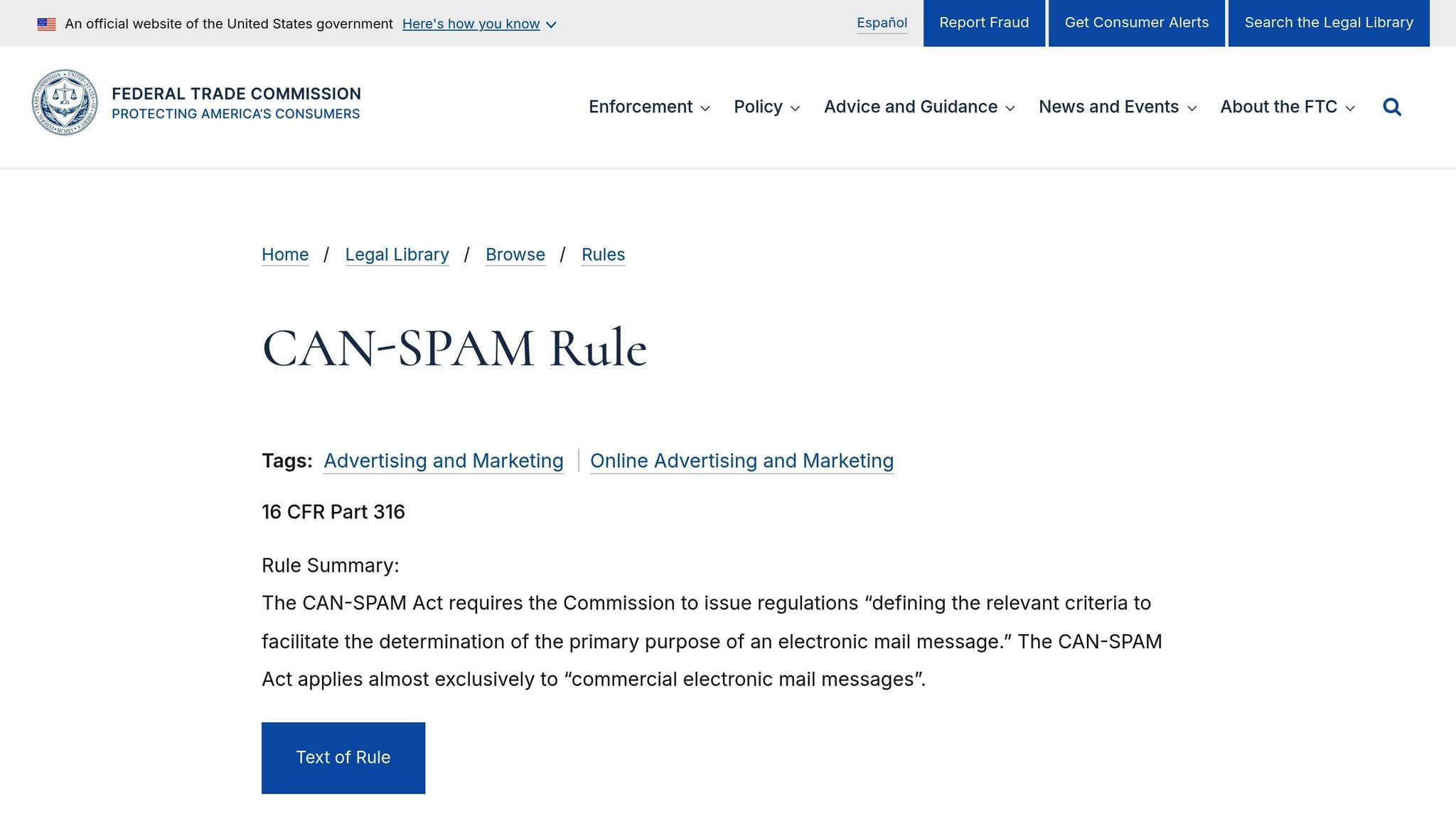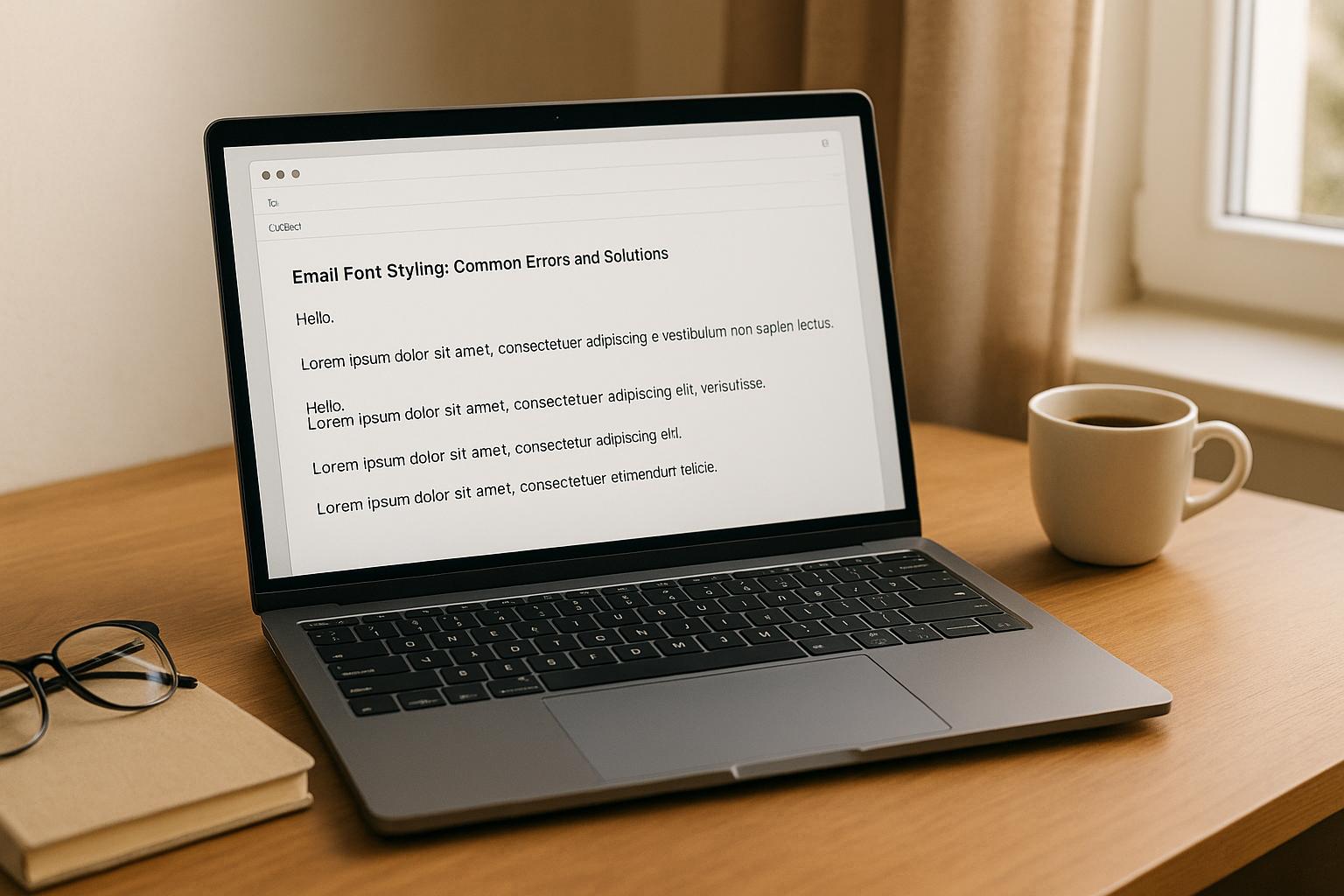Email marketing success depends on trust, especially in how personal data is handled. Consumers are increasingly cautious about sharing their information, making data privacy essential for building strong relationships. Here's what you need to know:
- Transparency is key. Clearly explain what data you collect, why, and how it’s used. Use plain language in privacy policies and consent forms.
- Consent matters. Always get explicit permission before sending emails. Double opt-in processes help confirm user interest.
- Privacy laws shape marketing. Regulations like GDPR, CCPA, and CAN-SPAM set rules for data use, consent, and email practices.
- Data breaches are costly. In 2023, the average cost of a breach was $4.45 million. Strong security measures protect both data and reputation.
- Personalization must respect privacy. Use only the data subscribers willingly share and limit unnecessary collection.
Personalization Vs. Privacy In Email Marketing? - TheEmailToolbox.com
Data Privacy Laws That Affect Email Marketing
Let’s dive deeper into how specific privacy laws influence email marketing practices. For email marketers, staying compliant with data privacy regulations is a must. Below, we’ll explore three major laws that directly impact email marketing.
GDPR: European Standards with Global Impact
The General Data Protection Regulation (GDPR) sets stringent rules for businesses handling personal data. If your email list includes even one subscriber from an EU country, GDPR applies to your operations, no matter where you’re located.
GDPR revolves around a consent-first model, requiring businesses to obtain active and informed consent before collecting or using personal data. It also gives individuals extensive rights, such as accessing, amending, or deleting their information. By prioritizing transparency and consent, GDPR not only safeguards data but also fosters trust among subscribers.
The penalties for non-compliance are no small matter. In 2022, GDPR violations resulted in fines totaling €2.92 billion, and in 2023, fines reached nearly €1.97 billion. Depending on the severity, penalties can soar as high as €20 million or 4% of a company’s global annual revenue, whichever is higher.
For those operating in the U.S., privacy laws like the CCPA add another layer of regulation, as explained next.
CCPA: California Consumer Protection Rules
The California Consumer Privacy Act (CCPA) applies to for-profit businesses that meet certain thresholds, such as generating annual revenues over $25 million or handling the data of 100,000 or more California residents.
The CCPA gives California residents more control over their personal data. This includes the right to know what data is collected, request its deletion, and opt out of its sale or sharing. Businesses must display clear privacy policies, notify users at the point of data collection, and provide mechanisms for opting out of data sales.
Failing to comply with CCPA can be costly, with intentional violations carrying fines of $7,988 per incident. Adhering to these rules not only avoids penalties but also strengthens trust by respecting consumer privacy.
"The law requires you, the sender, to comply, and most email marketing software has a robust indemnification provision."
– Rania Sedhom, Managing Partner, Sedhom Law Group, PLLC
CAN-SPAM Act: U.S. Email Marketing Rules

The CAN-SPAM Act governs commercial email practices in the United States. Unlike GDPR’s consent-based approach, CAN-SPAM operates on an opt-out model. This means you can send marketing emails without prior consent, provided you include an easy way for recipients to unsubscribe and honor their requests promptly.
Violating CAN-SPAM can lead to hefty fines - up to $53,088 per email. For instance, in 2023, the FTC imposed a $2.95 million penalty on Verkada for failing to include unsubscribe links and ignoring opt-out requests.
To comply with CAN-SPAM, emails must include:
- A physical postal address for your business.
- Clear and non-deceptive subject lines.
- A clear indication that the message is an advertisement.
- A functional and accessible unsubscribe option.
Recipients must be able to opt out within 10 business days, and your opt-out mechanism should remain active for at least 30 days after the email is sent.
"In accordance with GDPR … businesses must explicitly state what the subscribers are opting into and how the data will be used. There must also be a functioning and easy-to-find unsubscribe link in every email so that users can opt out with ease - it's a provision under … CAN-SPAM, CASL, and GDPR."
– Jeffrey Reisman, The Law Offices of Jeffrey I. Reisman
Mastering these regulations is key to creating email marketing campaigns that respect privacy rights while keeping your business out of legal trouble.
How to Follow Privacy Rules and Build Trust
Respecting privacy regulations isn't just about avoiding penalties - it’s a way to earn your subscribers' trust. When you handle their data responsibly, you create a foundation of trust that leads to better engagement and, ultimately, higher conversion rates.
Getting Clear Consent from Users
Trust begins with obtaining explicit consent. This means users should actively opt in, fully understanding what they’re agreeing to. Use simple, clear language to explain why you’re collecting their email addresses and what type of content they’ll receive, like newsletters, promotional offers, or product updates. Don’t tuck consent away in lengthy terms and conditions. Instead, provide a separate, unchecked box specifically for email marketing. This ensures you’re not using their information for ongoing marketing without their clear approval.
To take it a step further, implement a double opt-in process. This extra step confirms the user’s consent and helps maintain a more engaged email list. Also, let users know they can withdraw consent anytime, reinforcing your commitment to transparency.
Being Open About Data Collection and Use
Transparency is key when it comes to handling subscriber data. A significant number of consumers - nearly one-third - are hesitant to share their email addresses due to privacy concerns. To address this, write your privacy policies in plain, easy-to-understand language. Avoid legal jargon and clearly outline what data you collect, how it’s used, and whether it’s shared with third parties. Make this information easy to find by including links in website footers or email signatures.
Be upfront about data practices right from the sign-up process. Include key details about how you’ll use their information directly within consent requests. This sets clear expectations from the start. If you make changes to your privacy practices, notify your subscribers promptly. Offering multiple ways to contact you - like a dedicated email address, phone number, or mailing address - shows that you value their concerns and are open to communication.
Additionally, tools designed for compliance can help automate these transparency practices, saving time while maintaining trust.
Using Tools for Compliance
Once you’ve established trust through consent and transparency, leveraging the right tools ensures you stay compliant. Many modern email marketing platforms come with built-in compliance features, such as automatic inclusion of unsubscribe links, physical addresses, and consent tracking. These tools not only simplify compliance but also help you avoid costly mistakes. For example, violations of the CAN-SPAM Act can result in fines of up to $53,088 per email, while GDPR penalties can be as high as €20 million or 4% of annual revenue.
Automated tools like Email Governance can flag compliance issues in real time, allowing you to fix problems before they impact your subscribers. Centralized preference management systems are another great option, letting users update their preferences or contact information without needing to reach out to support. As Adelina Peltea, CMO of Usercentrics, puts it:
"Ensure unsubscribing or changing preferences is easily accessible and user-friendly to complete."
Regular audits are also a must. Peltea advises:
"Regularly review and audit regulatory compliance requirements, technologies in use, data held and its handling, consent status, and other relevant aspects of email and other marketing operations."
The Email Service Business Directory can be a helpful resource for finding platforms with strong compliance features tailored to your needs.
Finally, ensure your SPF, DKIM, and DMARC records are correctly configured, and test your unsubscribe links regularly. These measures not only help you avoid penalties but also strengthen the trust you’ve built with your audience.
sbb-itb-6e7333f
How to Be Transparent and Build Consumer Trust
Transparency isn't just about ticking compliance boxes; it's about earning trust by showing subscribers exactly how their data is handled. When you're upfront about your practices, you replace uncertainty with confidence, creating a foundation for a strong and lasting relationship.
Writing Clear Privacy Notices and Consent Forms
Your privacy policy shouldn't feel like it was written for lawyers. Instead, aim for clarity by using straightforward, easy-to-understand language. Avoid drowning readers in legal jargon or technical terms. Break up your policy into well-organized sections with clear headers and bullet points, helping readers quickly locate the information they need.
Explain how you collect data - whether it's through signup forms, checkboxes, or other methods - and be specific about how you'll use it for marketing purposes. Leading brands set a good example by clearly outlining the data they collect and how it's used, making it simple for users to understand and manage their consent.
Keep your privacy policy up to date as regulations change, and notify subscribers promptly about any major updates. Geoffrey Bourne, co-founder of Ayrshare, advises:
"The privacy policy must cover your own internal handling as well as those of third parties. Finally, consider the language you use. Over convoluted language can make the policy unclear to the public, instead use language that is easily understood by those who will ultimately read it."
Make your privacy policy easy to find by placing links in key areas like website footers, email signatures, and account settings pages. Also, provide multiple ways for subscribers to reach out with questions - such as a phone number, email address, or mailing address - to further reinforce trust.
Telling Users About Third-Party Data Sharing
Transparency about third-party data sharing is crucial for maintaining credibility. If you share subscriber data with service providers, be upfront about it in your privacy policy. Don’t bury this information in fine print - clearly explain why sharing is necessary and how it benefits the user.
Make sure to outline any third-party data-sharing practices and confirm that your partners meet privacy standards like GDPR and CCPA. Including links to their privacy policies can also help subscribers understand how their data is handled.
Conduct regular audits of your email marketing practices to ensure all third-party relationships remain transparent and compliant. Partner only with providers who have clear, secure, and up-to-date privacy policies. This level of transparency not only builds trust but also sets the stage for better overall practices.
Benefits of Being Transparent
Transparency in email marketing benefits both you and your subscribers. When people understand how their data is used, they’re more likely to trust you. This trust leads to stronger engagement, better deliverability, and healthier customer relationships.
By clearly communicating your data practices, you empower subscribers to make informed decisions - like opting out of marketing emails while still receiving essential account updates. For your business, these transparent practices reduce regulatory risks and help you build a subscriber base that genuinely values your communication.
In today’s world, where data privacy is a growing concern, being open about your practices isn’t just a good idea - it’s a competitive advantage. Platforms listed in the Email Service Business Directory can help you implement these best practices while staying compliant with privacy laws.
Up next, discover how to personalize emails effectively while keeping privacy intact.
Personalizing Emails While Protecting Privacy
Creating personalized email experiences requires a careful balance between using customer data and respecting their privacy. Surveys reveal that many consumers worry about data collection and personalization, making it essential to strike this balance for effective email marketing. Let’s dive into actionable ways to deliver targeted content without overwhelming or overstepping boundaries.
Using Data Properly for Personalization
The best personalization strategies rely on data that subscribers willingly share. This includes information gathered during signups, through preference centers, or from direct interactions.
Start by offering clear and specific choices during the signup process. Let subscribers decide what types of emails they'd like to receive - whether it's product updates, promotions, or newsletters. This ensures their consent and aligns your efforts with their actual preferences, steering clear of assumptions.
You can also use nonpersonal data, like browsing behavior or purchase history, to refine your targeting. For instance, if a subscriber frequently checks out hiking gear on your website, you could send them content about outdoor adventures, all without needing personal details.
Another approach is contextual personalization, which tailors emails based on broader factors like seasonal trends, location (with consent), or popular product categories. This method keeps your messaging relevant while reducing reliance on detailed personal data.
By handling data ethically, you not only improve personalization but also build trust with your audience.
"Personalization and privacy are often seen as opposing forces, but they don't have to be. The key lies in transparent communication and the ethical use of AI. Brands must show consumers the value they receive in exchange for their data." – Mary Chen, Chief Data Officer at DataFlow Inc.
Avoiding Excessive Data Collection
Collect only the data you genuinely need. This practice not only aligns with regulations like GDPR and CCPA but also reassures your audience. Over-collecting information can make customers uneasy, leading to distrust and reduced engagement. In this case, less is more.
Start simple. A name and email address are often enough to begin. If you want to offer birthday discounts, ask for birth dates. Planning a local event? Request location details. Every piece of information you collect should serve a clear, customer-focused purpose.
Avoid invasive profiling methods, such as tracking every single website visit or purchasing third-party data to build detailed customer profiles. These practices can feel intrusive, leaving customers uncomfortable and less likely to engage. Instead, focus on meaningful, value-driven interactions.
Preference centers are a great way to empower subscribers. These tools allow customers to decide what information they share and how it’s used, giving them control while helping you stay within clear personalization boundaries.
Regular Reviews of Data Practices
Ethical and compliant data use requires ongoing evaluation. Regular audits ensure your practices remain aligned with privacy standards and your evolving business needs.
Schedule quarterly reviews to assess what data you’re collecting, how it’s being used, and whether it’s still necessary. As your business changes, some data may become irrelevant. Removing outdated or unnecessary information shows your commitment to responsible data handling.
Incorporate technology audits into your routine as well. Companies that use AI-driven data anonymization tools report a 30% improvement in personalization accuracy while safeguarding privacy. Platforms listed in the Email Service Business Directory can help you find tools that balance effective personalization with ethical data use.
"Non-compliance with laws like GDPR or CCPA can cost companies millions, but the reputational damage is even harder to repair. A proactive approach to data governance is no longer optional - it's a business imperative." – David Lewis, VP of Data Strategy at SecureSync
Document your data collection and its purposes for transparency and accountability. This complements existing compliance measures and strengthens customer trust. Keep detailed records of consent, data usage, and any updates to your personalization strategies.
Lastly, prioritize staff training. Educating your team on data privacy principles ensures everyone understands the importance of ethical marketing practices. When privacy-first personalization becomes part of your company culture, compliance isn’t just a checkbox - it’s a natural part of how you operate.
Building Trust Through Data Privacy
Protecting customer data isn't just a compliance issue - it's a critical way to build trust and foster long-term relationships. In a world where people are increasingly protective of their personal information, showing a commitment to data privacy can set your business apart.
Why does this matter so much? Because privacy and trust go hand in hand. 96% of phishing attacks globally are delivered via email, and with over 56.5% of all emails sent in 2022 classified as spam, consumers have every reason to be wary. By taking data privacy seriously, you position your brand as a trustworthy ally in a privacy-conscious marketplace.
"In an era where consumers are increasingly aware of their personal information's value, prioritizing user data privacy is essential for protecting customer relationships and fostering brand loyalty." – Quantifi Media
Key Takeaways for Building Trust
1. Compliance is non-negotiable. Adhering to regulations like GDPR, CCPA, and CAN-SPAM isn't just about avoiding fines - it’s about showing customers you respect their rights. Since GDPR’s enforcement began in May 2018, France alone has recorded 5,389 personal data breaches, underscoring how seriously regulators take these issues.
2. Transparency matters. Clear privacy policies and open communication help customers understand how their data is used. Pairing this transparency with ethical personalization allows you to connect with your audience without crossing any boundaries.
3. Security is essential. Encryption, limited data access, and employee training on privacy practices are crucial for protecting both your customers and your reputation. A single data breach can undo years of trust, making robust security measures a must-have for any business.
"Data privacy is not just a legal requirement for marketers; it's a strategic imperative." – Rakesh Soni, CEO/Founder at LoginRadius
Next Steps for Businesses
To truly integrate privacy into your email marketing strategy, consider these actionable steps:
- Audit your current practices. Take a hard look at the data you're collecting, how it’s stored, and whether it’s truly necessary. Evaluate your consent processes and privacy policies to identify weak points.
- Start with the basics. Use explicit opt-in methods with clear checkboxes, provide easy-to-find unsubscribe options, and write your privacy policy in plain, straightforward language. These simple steps are the foundation of trustworthy marketing.
- Equip your team with the right tools and knowledge. Train your staff on privacy regulations and best practices. Invest in tools like SPF, DKIM, and DMARC to enhance email security. Platforms listed in resources like the Email Service Business Directory can help you find solutions that prioritize data protection while supporting effective campaigns.
- Turn privacy into a selling point. Rather than seeing privacy rules as hurdles, use them as an opportunity to differentiate your brand. Customers are more likely to engage with businesses they trust to handle their data responsibly.
Building trust through data privacy isn’t a one-and-done task - it’s an ongoing commitment. Regularly review your practices, update them as regulations evolve, and ensure your team stays informed. By making privacy a cornerstone of your strategy, you’ll not only strengthen customer relationships but also position your business for sustainable growth in an increasingly skeptical world.
FAQs
What are the key differences between GDPR, CCPA, and CAN-SPAM in email marketing and data privacy?
The GDPR puts a strong emphasis on safeguarding individual rights by mandating explicit consent before collecting or using personal data. It also prioritizes transparency, giving people more control over how their information is handled.
The CCPA takes a slightly different approach, focusing on consumer rights to access and opt out of data sharing. While it doesn’t always demand prior consent, businesses are required to offer clear options for users to opt out of data sales and ensure easy access to their personal information.
The CAN-SPAM Act is more lenient compared to the others. It allows businesses to send marketing emails without needing prior consent. However, it enforces certain rules, like requiring clear sender identification, honest subject lines, and a simple opt-out option to maintain compliance.
Although these regulations differ in their specifics, they all share a common goal: building trust and protecting consumer privacy in email marketing.
How can businesses comply with data privacy laws while creating personalized email marketing campaigns?
To align with U.S. data privacy laws such as the CCPA and CAN-SPAM Act while personalizing email campaigns, businesses need to emphasize transparency and secure user consent. Clearly communicate how customer data will be used, and make sure to obtain explicit permission before collecting or processing any information. Also, always offer a simple and accessible way for users to opt out of communications.
On top of that, safeguard customer data with strong security measures, minimize the duration you retain data, and only gather information that's essential for achieving your campaign objectives. By prioritizing compliance and building trust, businesses can deliver personalized marketing that respects privacy laws and customer expectations.
How can businesses build trust with email subscribers by communicating their data privacy practices?
To earn the trust of your email subscribers, it's essential to be upfront about your data privacy practices. Make sure your privacy policy is straightforward, written in plain language, and easy for anyone to understand. Clearly explain how you collect, use, and protect customer data. Always get explicit consent before gathering or using any information, and give subscribers control by offering options to manage their preferences.
Being transparent is non-negotiable. Keep subscribers in the loop by notifying them of any updates to your privacy practices. Additionally, working with reputable email marketing platforms shows your commitment to keeping their data safe. When you focus on compliance and maintain open communication, you create a foundation of trust and loyalty that can last for years.


